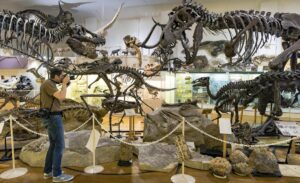Can Dinosaur Bichir Live With Cichlids
In the grand scheme of aquatic cohabitation, pairing dinosaur bichir with cichlids might seem like orchestrating a meeting between ancient rivals, yet this peculiar possibility has piqued the interest of many aquarists. The bichir, with its prehistoric lineage, and cichlids, known for their vibrant personalities, present a unique challenge.
One must consider their distinct temperaments, environmental needs, and dietary habits to envision a harmonious tank. But does the secret to successful cohabitation lie in meticulous planning or is it merely a hopeful gamble?
Let's explore the intricacies of merging these worlds, keeping in mind the fine balance between nature's rules and an aquarist's ambition.
Key Takeaways
- Dinosaur Bichir's docile nature allows cohabitation with less aggressive cichlid species.
- A spacious tank is essential to mitigate territorial conflicts between the two species.
- Varied dietary needs necessitate tailored feeding strategies for peaceful coexistence.
- Incorporating hiding spots and maintaining optimal water conditions are crucial for both species' health.
Understanding Dinosaur Bichir
The Dinosaur Bichir, scientifically known as Polypterus senegalus, is a prehistoric fish species that showcases unique evolutionary adaptations, enabling it to thrive in diverse aquatic environments. Originating from freshwater habitats in Africa, this species possesses an elongated body and scales that resemble those of ancient fishes, contributing to its prehistoric appearance.
Notably, the Dinosaur Bichir exhibits a remarkable respiratory system that allows it to breathe atmospheric air using a specialized swim bladder, functioning similarly to lungs. This adaptation ensures its survival in oxygen-poor waters, providing a significant advantage over other fish species.
Furthermore, it's equipped with strong pectoral fins that enable it to maneuver skillfully in water, highlighting its evolutionary prowess to adapt and flourish in varying ecological conditions.
Characteristics of Cichlids
Cichlids exhibit a wide range of behavioral traits, which are crucial for their survival and reproduction in diverse environments. Their habitat preferences vary significantly, with some species thriving in rocky, freshwater lakes while others prefer slow-moving rivers or sand-based environments.
Understanding these characteristics is essential for assessing the compatibility of cichlids with dinosaur bichirs in shared aquatic spaces.
Cichlid Behavioral Traits
Known for their complex social structures, cichlids exhibit a wide range of behaviors, including territorial aggression, sophisticated breeding rituals, and unique parenting styles. These freshwater fish demonstrate a high degree of intelligence and emotional complexity, often engaging in behaviors that reflect careful planning and social manipulation.
For instance, some cichlid species use decoys to distract predators from their young, showcasing their advanced cognitive abilities. Furthermore, their aggressive territorial behavior isn't merely an act of random violence but a calculated strategy to secure the best possible breeding grounds and food resources. This aggression varies significantly across species and is influenced by environmental factors.
Cichlid breeding rituals are equally intricate, involving elaborate dances and color displays to attract mates, further highlighting their behavioral complexity.
Cichlid Habitat Preferences
Understanding the intricate social and behavioral complexities of cichlids leads us naturally to explore their specific habitat preferences, which are equally vital for their survival and well-being. Cichlids exhibit a remarkable diversity across various ecosystems, yet they share common environmental needs that are crucial for their thriving. These include:
- Water Quality: Cichlids require clean, well-oxygenated water with stable pH levels. Sudden changes can stress them, affecting their health.
- Temperature: They thrive in warm waters, with most species preferring temperatures between 74°F to 80°F (23°C to 27°C), mimicking their natural tropical habitats.
- Complex Environments: They favor environments rich in hiding spots and territories, such as those with rocks, caves, and plants. This complexity supports their social structures and breeding behaviors, making it essential for their psychological and physical health.
Temperament Considerations
Evaluating the compatibility of dinosaur bichirs with cichlids necessitates a thorough analysis of aggression levels and territorial demands.
Bichirs exhibit a relatively docile temperament, contrasting sharply with the often aggressive and territorial nature of many cichlid species.
This disparity in behavior underscores the importance of assessing space needs and environmental structures to mitigate potential conflicts within a shared habitat.
Aggression Levels Compared
How do the aggression levels of dinosaur bichirs compare with those of cichlids, and what implications does this have for cohabitation in an aquarium setting? Understanding the temperament of both species is crucial for a harmonious tank environment.
- Dinosaur bichirs generally exhibit a more placid demeanor compared to many cichlids, which are known for their territorial aggression.
- The variability in aggression among cichlid species means some are more compatible with bichirs, especially less aggressive cichlids.
- Stress and conflict can arise if aggressive cichlids dominate the tank, potentially leading to injury.
These dynamics underscore the importance of carefully selecting tank mates based on individual species' behavior. A thorough understanding of each species' temperament can facilitate a peaceful aquarium community.
Territory and Space Needs
Assessing the space and territory needs of dinosaur bichirs and cichlids is critical for maintaining a balanced and stress-free aquarium environment.
Dinosaur bichirs, being bottom-dwellers, require ample floor space to roam and explore without competition.
Cichlids, on the other hand, are territorial and often claim regions within the tank. They're known for their complex social structures and need sufficient room to establish territories, reducing conflicts.
A densely populated tank can lead to stress, health issues, and aggression. Ideally, an aquarium housing both species should be spacious, with strategic placement of rocks and plants to create natural boundaries and hideaways.
This setup allows cichlids to establish territories while providing bichirs with the necessary space to thrive, fostering a harmonious cohabitation.
Environmental Requirements
To ensure harmony and health when housing Dinosaur Bichir with Cichlids, understanding their shared environmental needs is crucial. These prehistoric and vibrant fish species cohabit more successfully when their aquatic environment aligns closely with their natural habitats. This includes:
- Temperature: Both species thrive in water temperatures ranging from 75°F to 82°F. This range supports their metabolic processes and contributes to their overall well-being.
- pH Level: A neutral to slightly acidic pH level, between 6.5 and 7.5, is ideal. This range mimics their natural riverine environments, promoting healthy skin and gill function.
- Water Hardness: Moderate water hardness, around 5-15 dGH, ensures the water chemistry supports their physiological needs without causing stress or harm.
Maintaining these parameters requires regular monitoring and adjustments, ensuring both species can thrive together in a shared tank environment.
Diet and Nutrition Needs
Understanding the diet and nutrition needs of both Dinosaur Bichir and Cichlids is crucial for their cohabitation.
The varied dietary preferences of these species necessitate a careful analysis of their protein requirements and how they compare.
Additionally, the differences in feeding frequency between the two species highlight the importance of establishing a feeding regimen that supports the health and wellbeing of both.
Varied Dietary Preferences
When evaluating the compatibility of dinosaur bichir and cichlids, it's crucial to consider their distinct dietary preferences, as these fish species have evolved with unique nutritional requirements that must be met for optimal health. The dietary needs of both species are shaped by their natural habitats and foraging behaviors, leading to a nuanced understanding of their compatibility in shared environments.
- Dinosaur Bichir: Primarily carnivorous, they rely on a diet rich in meats, including live or frozen prey such as bloodworms and brine shrimp.
- Cichlids: Exhibit more varied feeding habits, ranging from strictly herbivorous to omnivorous, depending on the species. Their diet can include algae, vegetables, and smaller fish or insects.
- Environmental Impact: The dietary preferences of each species can influence tank conditions, requiring careful management of food sources to maintain water quality and prevent competition.
Protein Requirements Comparison
In comparing the dietary needs of dinosaur bichir and cichlids, it's evident that bichirs require a significantly higher intake of protein due to their carnivorous nature, whereas cichlids' protein needs vary widely based on their specific dietary habits, ranging from herbivorous to omnivorous. This distinction underscores the importance of understanding the natural feeding behaviors of each species to ensure their dietary needs are met in a shared habitat.
Bichirs thrive on a diet rich in meaty foods, including worms and small fish, highlighting their need for animal-based proteins. Conversely, cichlids may adapt to a more varied diet, incorporating both plant and animal sources, depending on their species-specific requirements. This variability in protein needs presents a challenge in managing a balanced diet within a communal aquarium, necessitating careful consideration and planning to accommodate the nutritional preferences of each species.
Feeding Frequency Differences
Considering the contrasting dietary needs between dinosaur bichir and cichlids, it's crucial to address their feeding frequency differences to ensure optimal health and nutrition within a shared aquarium environment.
Dinosaur bichirs, being carnivorous, generally require less frequent feedings, focusing on quality over quantity. In contrast, cichlids, with their varied diets, often need more consistent feeding schedules. Here's a breakdown:
- Dinosaur Bichir: Typically, they thrive on 2-3 feedings per week, preferring live or frozen proteins.
- Cichlids: Require daily feedings, with a diet that includes both plant-based and protein-rich foods to meet their nutritional needs.
- Shared Environment: Balancing these needs involves strategic feeding times and zones within the tank to prevent competition and ensure each species receives its necessary diet.
Size and Growth Differences
Dinosaur Bichir and cichlids exhibit significant disparities in their growth rates and maximum sizes, factors that are crucial for compatibility in a shared habitat. Typically, Dinosaur Bichirs can grow to lengths exceeding 24 inches, showcasing a more gradual growth curve.
In contrast, many cichlid species, depending on their specific type, often reach their full size, ranging from 4 to 12 inches, at a faster rate. This size difference doesn't just influence spatial requirements but also impacts social dynamics within the tank.
Larger Bichirs might inadvertently intimidate or prey upon smaller cichlid species, especially in confined spaces. Conversely, aggressive cichlids might stress slower-growing, more docile Bichirs. Understanding these growth and size variations is essential for fostering a harmonious environment, ensuring both species thrive without infringing on each other's well-being.
Tank Setup Strategies
To foster a harmonious aquatic environment for Dinosaur Bichir and cichlids, tank setup must prioritize ample space, strategic hiding spots, and water conditions tailored to meet the diverse needs of both species. A thoughtful approach will mitigate potential stress and aggression, promoting a stable and enriched habitat.
Consider the following:
- Tank Size: A minimum of 75 gallons is essential to accommodate the territorial nature and size of both fish.
- Hiding Spots: Implement a variety of caves, driftwood, and plants to provide refuge and reduce competition for territory.
- Water Parameters: Ensure a temperature range of 75-82°F, pH levels between 6.5-7.5, and moderate water flow to mimic their natural environments and meet their physiological requirements.
These strategies are crucial for maintaining the well-being of both species in a shared tank.
Potential Health Concerns
While a well-thought-out tank setup mitigates many risks, it's crucial to remain vigilant about potential health concerns that can arise when housing Dinosaur Bichir with cichlids. These species have distinct environmental and dietary requirements, potentially leading to stress and nutritional deficiencies if not properly managed. Stress weakens the immune system, making fish more susceptible to diseases like Ichthyophthirius multifiliis, commonly known as 'Ich,' and other parasitic infections.
Furthermore, aggressive interactions, more common among cichlids, can result in physical injuries, opening pathways for bacterial and fungal infections. It's essential to monitor water quality closely, as both species produce significant waste, contributing to nitrate and ammonia spikes. These fluctuations stress the aquatic ecosystem, further exacerbating health vulnerabilities. Hence, maintaining a balanced, clean, and stress-free environment is paramount for the well-being of both Dinosaur Bichirs and cichlids.
Successful Co-habitation Tips
Achieving harmony between Dinosaur Bichir and cichlids in a shared tank requires meticulous attention to their environmental needs and behaviors. To facilitate successful cohabitation, consider the following:
- Tank Size and Layout: A spacious tank, ideally upwards of 75 gallons, allows for adequate territory establishment. Incorporating plants, caves, and hiding spots can prevent territorial disputes and reduce stress.
- Water Parameters: Consistently maintain optimal water conditions, including temperature, pH, and cleanliness. Both species thrive in slightly acidic to neutral water, with temperatures ranging from 75°F to 82°F. Regular water changes are crucial to remove toxins and maintain water quality.
- Feeding Strategies: Implement a diverse feeding regimen to cater to both species' dietary needs, reducing competition for food. Providing live, frozen, and pellet foods at different tank locations can ensure both species receive adequate nutrition without direct conflict.
Real-Life Aquarist Experiences
Drawing from a wealth of shared experiences, many aquarists report that with careful planning and monitoring, Dinosaur Bichir and cichlids can coexist peacefully in a well-maintained aquarium. They've found that the key lies in understanding each species' behavioral patterns and environmental needs.
Aquarists emphasize the importance of providing ample space to prevent territorial disputes, especially since cichlids are known for their assertive demeanor. They also highlight the necessity of creating numerous hiding spots to offer refuge and reduce stress among the aquatic inhabitants.
Observations suggest that a diet tailored to meet the nutritional requirements of both species can minimize competition for food, further promoting harmony. Regular water quality checks are crucial to ensure the health and well-being of both Dinosaur Bichir and cichlids, underscoring the importance of diligent aquarium management.
Conclusion
In the dance of aquatic cohabitation, dinosaur bichirs and cichlids can indeed share the stage, provided the choreography of their environment is meticulously planned. Like a well-rehearsed ballet, success hinges on harmonizing their needs—from temperament to diet, ensuring neither steps on the other's toes.
An aquarist recounted transforming their tank into this harmonious ecosystem, illustrating that with careful consideration and strategic setup, these diverse species can perform in unison, showcasing the beauty of aquatic diversity.




